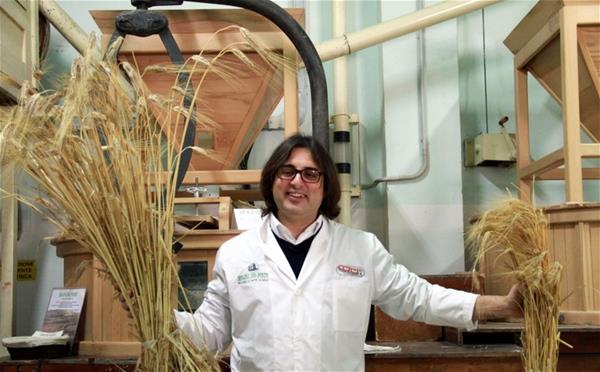If you want really flavorful pasta, the first step is to start with really flavorful wheat. That’s exactly what Filippo Drago is doing in western Sicily. He’s working to put Tumminia wheat—and the pasta he makes from it—on the global culinary map.
Tumminia wheat has been grown in Sicily since the Greeks lived there.
It’s been passed down for generations across thousands of years because it is particularly sweet and aromatic, with a flavor hinting at chamomile, hazelnuts, and toasted almonds. However it’s low-yielding, meaning it takes a lot of land to grow not very much wheat. In the 1960s, when a glut of new, high-yielding wheat took Italian agriculture by storm, farmers stopped growing Tumminia to focus on the new varietals. But while there was more new wheat, it was not more flavorful. It lacked the nuance and complexity of old heirloom grains like Tumminia.
Lucky for us, a few dedicated farmers around the town of Castelvetrano, near Trapani in western Sicily, kept growing the Tumminia. They grew it mostly so they could keep making their famous local bread: Pane Nero di Castelvetrano. Pane Nero, or “black bread” in English, gets its name from its deep brown color, a product of being made with dark Tumminia wheat. The flavor is remarkably sweet—it almost tastes like there’s sugar or honey in the dough, but there isn’t. It’s just the natural sweetness of the wheat.
Tumminia is a durum wheat. Durum wheats have a much higher protein content than the flour you buy at the grocery store. When you make a dough with durum wheat, it’s super firm and not that easy to work with. That’s a disadvantage for bread and pastry, but it’s exactly what you want for making pasta. Essentially all of the pasta out there, from the cheap grocery store stuff to the best of the best, is made from durum wheat.
Enter Filippo Drago—miller, baker, pasta maker.
Filippo runs a grain mill called Molini del Ponte in Castelvetrano. The mill has been in his family for four generations. The heart of Molini del Ponte is his pair of old stone mills. The industry standard is modern roller mills which separate the germ and the wheat from the endosperm, or white part, of the grain. They do that because the germ and bran contain fats which make the flour go rancid. Roller mills produce flour that is ultraprocessed and will last basically forever. However, that flour has been stripped of essentially all of its nutrients and the vast majority of its flavor. The germ and the bran contain most of the grain’s flavor, so to produce really flavorful flour you need to keep them intact. Stone mills do that. They grind the whole grain more slowly and at a lower temperature. The result is a flour that’s much, much more flavorful.
Preserving the flavor has been especially important at Molini del Ponte since Filippo started his work to get more local heirloom wheats. For the last several years, he’s been coordinating with local farmers to grow grains like Tumminia along with a half-dozen other ancient wheats. To make up for the lower yield, heirloom wheats like Tumminia cost three times more than modern varieties. But the difference in flavor is more like a hundredfold. Thanks to Filippo’s work there’s more Tumminia wheat available than there has been in decades—and for the first time it’s now being exported to bakers like our crew at Zingerman’s Bakehouse, who are using it to make Pane Nero here in Ann Arbor.
But Filippo doesn’t just mill flour. He also bakes bread and, importantly for us, he makes pasta: a traditional shape from western Sicily called busiate. In the local dialect, “busa” means a yarn used when knitting, and the tight corkscrew twists of the busiate do resemble strands of yarn. They’re a rich chestnut color from the dark color of the wheat, and the flavor is remarkable: huge, sweet, nutty, rich.
The traditional way to eat Busiate is with Pesto Trapanese.
Pesto Trapanese is the favorite sauce in Trapani, where they use a mortar and pestle to grind almonds, tomatoes, basil, garlic, and olive oil into a smooth spread that’s killer on crostini or pasta. Caper pesto from Pantelleria, an island off the western coast of Sicily, is another excellent, traditional pairing. The busiate’s twists and rough texture grip sauce better than any other pasta I’ve tried.
Cook the pasta in plenty of boiling water with enough salt to make the water “salty like the sea.” While the pasta is cooking, scoop out a bit of the cooking water from the frothiest part of the pot. The pasta is done when it’s al dente: cooked through, but still with a bit of chewy bite. When you dress the pasta with the pesto, stir in a bit of the water. The pestos are super concentrated, and thinning them out a bit with some of the starchy, salted water helps turn them into a creamy sauce that sticks to the pasta. Serve the pasta immediately while it’s piping hot—in Italy, when pasta is served, conversation around the table pauses so that everyone can eat as quickly as possible.

